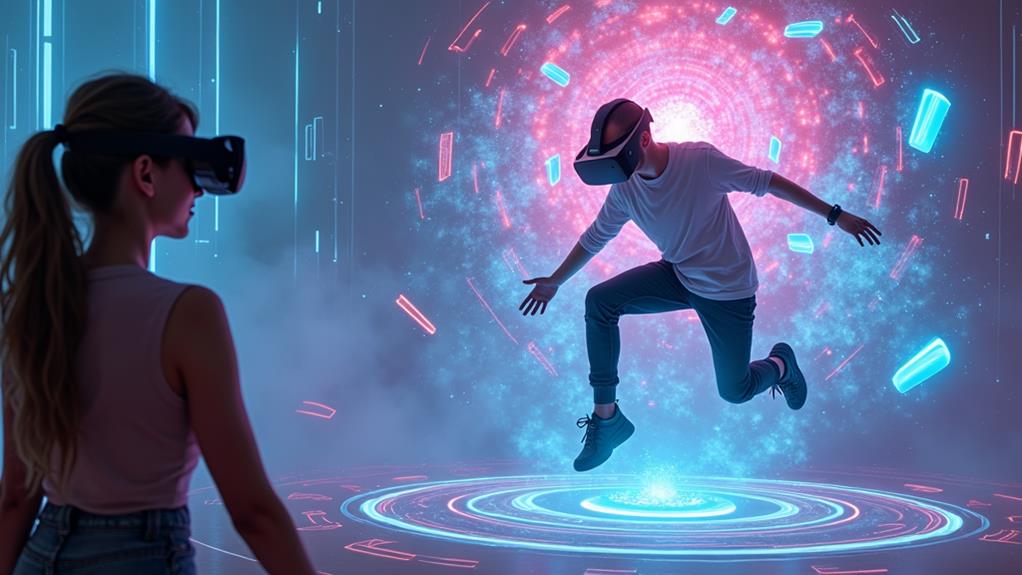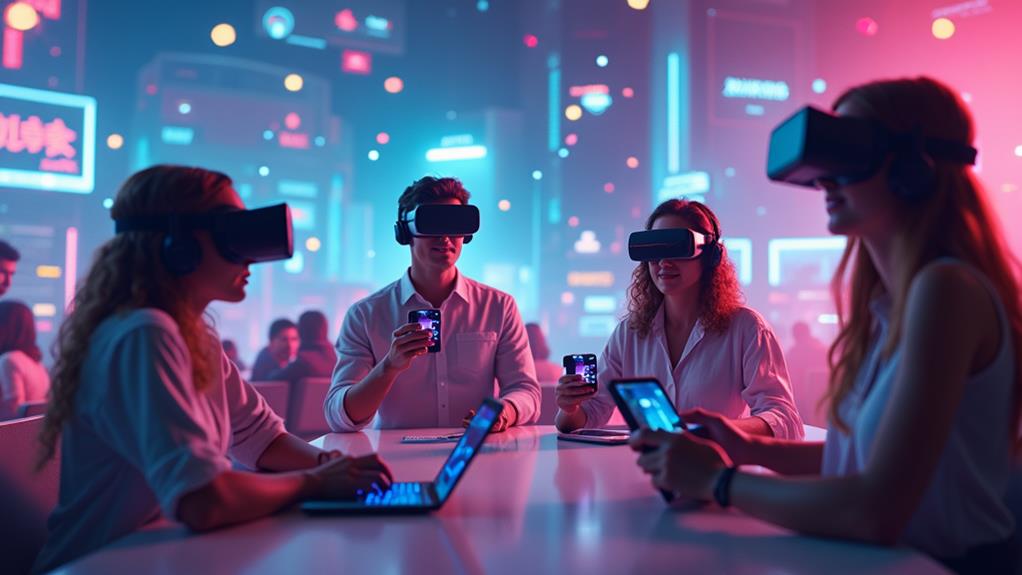
Virtual reality (VR) and augmented reality (AR) are transforming the gaming landscape, offering unprecedented levels of immersion and engagement. You'll experience fully realized virtual worlds with VR, while AR blends digital elements with your real environment. Both technologies are advancing rapidly, pushing the boundaries of storytelling and social connectivity in gaming. Despite challenges like high costs and hardware limitations, the market is projected to grow substantially. As these technologies evolve, you can expect more accessible and innovative gaming experiences that blur the line between virtual and physical realities. The future of gaming holds exciting possibilities that will redefine how you interact with digital content.
VR and AR Market Growth
The VR and AR market has experienced explosive growth in recent years. You'll find that the gaming industry has been at the forefront of this revolution, driving market growth through innovative and immersive experiences. Virtual Reality Gaming has seen a surge in popularity, with VR headsets becoming more accessible and affordable. Meanwhile, Augmented Reality has found its way into mobile gaming, blending digital elements with the real world.
As you explore this evolving landscape, you'll notice that technological advancements are constantly pushing the boundaries of what's possible in AR/VR Gaming. The market is projected to continue its upward trajectory, with analysts predicting substantial growth in the coming years. You're witnessing a shift in how people interact with digital content, as VR and AR technologies offer unprecedented levels of immersion and engagement.
From enhanced graphics to more intuitive controls, these innovations are transforming the gaming experience. As a tech enthusiast, you'll want to keep an eye on emerging trends in this space, as VR and AR continue to reshape not just gaming, but various industries across the board.
Technological Advancements in Gaming
Groundbreaking technological advancements have revolutionized the gaming landscape in recent years. You're now witnessing an era where Virtual Reality (VR) and Augmented Reality (AR) are at the forefront of gaming innovation. These technologies are transforming how you interact with digital worlds, offering unprecedented levels of immersion.
VR technology has made significant strides in creating realistic environments that transport you to entirely new domains. With high-resolution displays, advanced motion tracking, and haptic feedback, VR games now provide incredibly lifelike experiences. You'll find yourself fully engaged in virtual worlds, where your movements and actions directly impact the game.
AR gaming, on the other hand, blends digital elements with your real-world surroundings. This technology enhances your existing environment, adding interactive layers that create unique and engaging gameplay. You'll discover new ways to explore your surroundings as AR games overlay digital content onto the physical world.
Both VR and AR are pushing the boundaries of immersive gaming, offering experiences that were once thought impossible. As these technologies continue to evolve, you can expect even more innovative and enthralling gaming experiences in the future.
Immersive Experiences and Storytelling

Immersive experiences and storytelling have taken center stage in both VR and AR gaming, revolutionizing how you engage with narratives. Virtual Reality plunges you into fully realized virtual worlds, where you're not just observing the story, but living it. You'll find yourself as the protagonist, making decisions that shape the narrative and interacting with characters in ways previously unimaginable.
AR, on the other hand, blends storytelling with your real environment. It transforms your surroundings into a canvas for interactive narratives, where digital elements seamlessly integrate with the physical world. You might solve mysteries in your own living room or battle aliens in your backyard.
Both technologies empower content creators to craft new dimensions of storytelling. In VR, you'll experience emotional depth and presence like never before, feeling genuinely connected to the virtual characters and environments. AR offers a unique blend of reality and fiction, allowing you to see familiar spaces in entirely new ways.
As these technologies advance, the line between gaming and immersive storytelling continues to blur, offering you unprecedented ways to experience and interact with narratives.
Challenges and Opportunities
Despite the exciting potential of AR and VR gaming, significant challenges remain. The high cost of entry for consumers and hardware limitations pose obstacles to widespread adoption. You'll find that powerful processing capabilities and high-quality displays make AR and VR devices expensive, putting them out of reach for many gamers. Additionally, developers and content creators face hurdles in acquiring the necessary skills and technology to produce compelling AR and VR experiences.
However, these challenges also present opportunities for innovation within the industry. The integration of AR and VR into mobile gaming opens new avenues for reaching a wider audience, potentially revolutionizing the gaming experience. As the market continues to grow, with projections reaching $10,110 million by 2029, you can expect to see increased investment in overcoming these obstacles.
The pursuit of more immersive experiences will drive innovation in game design, user interfaces, and storytelling. As a gamer or developer, you'll witness the evolution of Virtual Reality and Augmented Reality technologies, leading to more accessible and engaging experiences. The industry's focus on creating truly immersive worlds will push the boundaries of what's possible in gaming, offering exciting prospects for the future.
Social Gaming and Connectivity

The rise of AR and VR technologies is revolutionizing social gaming and connectivity. As you explore these immersive worlds, you'll find that the boundaries between virtual and real-world interactions are blurring. With 69% of industry experts predicting mainstream adoption within five years, you're on the cusp of a social gaming revolution.
Virtual Reality platforms like VRChat and Rec Room have already paved the way for immersive social experiences, allowing you to interact with others in virtual worlds. But Augmented Reality takes it a step further, enabling you to engage with your real-world friends in augmented environments overlaid on your physical surroundings. This fusion of realities creates unprecedented opportunities for social connections and multiplayer experiences.
As cloud gaming and streaming services advance, you'll have access to high-quality AR and VR social experiences without needing expensive hardware. This democratization of technology will further expand social gaming and connectivity opportunities. The future of multiplayer gaming is bright, with AR and VR at the forefront, redefining how you connect with others regardless of physical distance. Get ready to embrace a new era of social gaming that seamlessly blends virtual and real-world interactions.
Conclusion
As you've seen, VR and AR are reshaping gaming's future. You'll experience more immersive worlds and innovative storytelling. While challenges remain, technological advancements are addressing them rapidly. You're likely to witness a blend of both technologies, offering unique experiences tailored to different preferences. Whether you're diving into virtual domains or enhancing your real world, the future of gaming is bright. Get ready for an exciting journey where reality and imagination intertwine.
As an Amazon Associate I earn from qualifying purchases.







